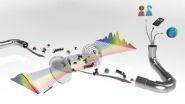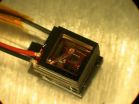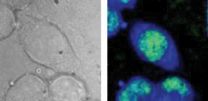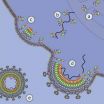(Press-News.org) Scientists at JILA and collaborators have demonstrated an improved laser-based "molecular fingerprinting" technique that picks out traces of key hydrogen-containing and other molecules from a billion other particles in a gas in just 30 seconds or less—performance suitable for breathalyzers for diagnosing disease, measuring trace gases in the atmosphere, detecting security threats and other applications.
JILA is jointly operated by the National Institute of Standards and Technology (NIST) and University of Colorado at Boulder (CU).
Described in Optics Express,* the research extends the range of an existing NIST/JILA invention** to cover the mid-infrared region of the electromagnetic spectrum. This is a critical range, because it includes the frequencies associated with strong molecular vibrations, including various hydrogen bonds. The technology thus can identify a much wider variety of molecules, including virtually any containing hydrogen—the most common element in the universe—and can measure lower concentration levels than before.
The heart of the JILA system is an optical frequency comb, a tool generated by ultrafast lasers that precisely identifies a wide range of different colors of light. Researchers identify specific molecules based on which colors of light, or comb "teeth," are absorbed by a gas, and in what amounts. The comb light usually passes through a gas mixture many times, significantly improving detection sensitivity. Concentrations are measured with the help of molecular "signatures" assembled from databases. The technique works quickly and reliably even when molecules have overlapping, continuous, or otherwise confusing absorption signatures. The rapid data collection, in particular, makes the technology suitable to replace or surpass conventional Fourier transform infrared (FTIR) spectrometers for many applications, according to the paper.
In the demonstration, scientists measured a dozen important molecules at parts-per-billion precision, including the greenhouse gases methane, carbon dioxide, and nitrous oxide; and the pollutants isoprene and formaldehyde. In addition, the system detected molecules useful in human breath analysis: ethane (a sign of asthma) and methanol (a sign of kidney failure). The system is able to reach parts-per-trillion sensitivity for the first time in detecting carbon dioxide.
Collaborators from IMRA America, Inc. (Ann Arbor, Mich.), developed the fiber laser used to make the frequency comb. The comb itself is based on a non-linear optical process that shifts the light from the near-infrared to the mid infrared. The JILA researchers now plan to extend the system further into longer wavelengths to cover a second important molecular fingerprinting region, to identify a more diverse set of complex molecules containing carbon, and to modify the equipment to make it portable. Planning is also under way for clinical trials of the breathalyzer application.
INFORMATION:
The research is funded by the Air Force Office for Scientific Research, Defense Advanced Research Projects Agency, the Agilent Foundation, NIST, and the National Science Foundation.
* F. Adler, P. Mas?owski, A. Foltynowicz, K.C. Cossel, T.C. Briles, I. Hartl and J. Ye. Mid-Infrared frequency comb Fourier transform spectroscopy with a broadband frequency comb. Optics Express, Vol. 18, No. 21. Oct. 11, 2010.
** J. Ye, M.J. Thorpe, K. Moll and J.R. Jones. U.S. Patent number 7,538,881, "Sensitive, Massively Parallel, Broad-Bandwidth, Real-Time Spectroscopy," issued in May 2009, NIST docket number 06-004, CU Technology Transfer case number CU1541B. Licensing rights have been consolidated in CU. See more in "Optical 'Frequency Comb' Can Detect the Breath of Disease ," in NIST Tech Beat for Feb. 19, 2008, at http://www.nist.gov/public_affairs/techbeat/tb2008_0219.htm#comb.
JILA unveils improved 'molecular fingerprinting' for trace gas detection
2010-10-15
ELSE PRESS RELEASES FROM THIS DATE:
CR Magazine sheds light on the burden of cancer on the streets
2010-10-15
PHILADELPHIA — An article published in the Ffall 2010 issue of CR, the AACR's magazine for cancer survivors and their families and caregivers, details the immense challenges faced by those who suffer with cancer and lack the necessary resources for proper treatment and care — the homeless.
CR magazine contributing writer Cynthia Ryan, Ph.D., who is an associate professor of English at the University of Alabama at Birmingham, took to the streets over the last year to offer a glimpse into the lives of homeless cancer patients struggling to obtain treatment while being ...
Cyberwars: Already underway with no Geneva Conventions to guide them
2010-10-15
BUFFALO, N.Y. -- Cyber attacks of various sorts have been around for decades. The most recent, and very dangerous, escalation in the past few years has been marked by countries launching attacks against other nations, such as Stuxnet, the nuclear plant-disrupting worm the Iranians have blamed on Israel and the U.S., while others are pointing the finger at Russia.
University at Buffalo military ethicist Randall R. Dipert, PhD, one of the founders of the National Center for Ontological Research at UB, says we have good reason to worry, because cyber attacks are almost ...
Is anxiety contagious?
2010-10-15
Anxiety, or the reaction to a perceived danger, is a response that differs from one animal or human to another ― or so scientists thought. Now researchers at Tel Aviv University are challenging what we know about stress, and their study has implications for helping clinicians better treat victims of terrorism or natural disasters.
Prof. David Eilam and his graduate student Rony Izhar of Tel Aviv University's Department of Zoology are spearheading a study designed to investigate the anxieties experienced by an entire social group. Using the natural predator-and-prey ...
NIST mini-sensor traces faint magnetic signature of human heartbeat
2010-10-15
Researchers from the National Institute of Standards and Technology (NIST) and the German national metrology institute have used NIST's miniature atom-based magnetic sensor to successfully track a human heartbeat, confirming the device's potential for biomedical applications.
Described in Applied Physics Letters,* the study is the first to be performed under conditions resembling a clinical setting with the NIST mini-sensors, which until now have been operated mostly in physics laboratories. The new experiments were carried out at the Physikalisch Technische Bundesanstalt ...
Biologists identify influence of environment on sexual vs. asexual reproduction
2010-10-15
TORONTO, ON – Evolutionary biologists at the University of Toronto (U of T) have found that environment plays a key role in determining whether a species opts for sexual over asexual reproduction.
The study, led by post-doctoral student Lutz Becks and Professor Aneil Agrawal of the Department of Ecology & Evolutionary Biology, found that species that inhabit spatially heterogenous environments – habitats characterized by uneven concentrations of its own species among a rich variety of other animals and plants – had higher rates of sexual reproduction than those in more ...
Faster CARS, less damage: NIST chemical microscopy shows potential for cell diagnostics
2010-10-15
A paper by researchers at the National Institute of Standards and Technology (NIST) may breathe new life into the use of a powerful—but tricky—diagnostic technique for cell biology. The paper,* appearing this week in the Biophysical Journal, demonstrates that with improved hardware and better signal processing, a powerful form of molecular vibration spectroscopy can quickly deliver detailed molecular maps of the contents of cells without damaging them. Earlier studies have suggested that to be useful, the technique would need power levels too high for cells.
The technique, ...
New look at multitalented protein sheds light on mysteries of HIV
2010-10-15
New insights into the human immunodeficiency virus (HIV) infection process, which leads to acquired immunodeficiency syndrome (AIDS), may now be possible through a research method recently developed in part at the National Institute of Standards and Technology (NIST), where scientists have glimpsed an important protein molecule's behavior with unprecedented clarity.
The HIV protein, known as Gag, plays several critical roles in the assembly of the human immunodeficiency virus in a host cell, but persistent difficulties with imaging Gag in a lab setting have stymied researchers' ...
New small business law could have big effect on retirement accounts
2010-10-15
CHAMPAIGN, Ill. – A new law aimed at helping stimulate small business job growth through tax deductions could have major consequences for anyone with a retirement savings account at work, a University of Illinois expert on taxation and elder law notes.
Law professor Richard L. Kaplan says an obscure provision in the recently enacted Small Business Jobs Act allows 401(k), 403(b) or 457 account holders to convert their retirement savings into a tax-advantaged Roth-version of the same account.
The good news, according to Kaplan, is that by converting to a Roth variant, ...
This little light of mine: Changing the color of single photons emitted by quantum dots
2010-10-15
Researchers at the National Institute of Standards and Technology (NIST) have demonstrated* for the first time the conversion of near-infrared 1,300 nm wavelength single photons emitted from a true quantum source, a semiconductor quantum dot, to a near-visible wavelength of 710 nm. The ability to change the color of single photons may aid in the development of hybrid quantum systems for applications in quantum communication, computation and metrology.
Two important resources for quantum information processing are the transmission of data encoded in the quantum state of ...
Charcoal biofilter cleans up fertilizer waste gases
2010-10-15
Removing the toxic and odorous emissions of ammonia from the industrial production of fertilizer is a costly and energy-intensive process. Now, researchers in Bangladesh have turned to microbes and inexpensive wood charcoal to create a biofilter that can extract the noxious gas from vented gases and so reduce pollution levels from factories in the developing world.
Writing in the International Journal of Environment and Pollution, Jahir Bin Alam, A. Hasan and A.H. Pathan of the Department of Civil and Environmental Engineering, at Shahjalal University of Science and Technology, ...






